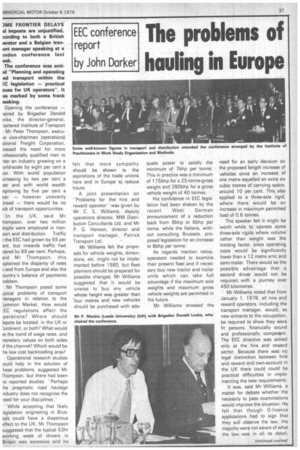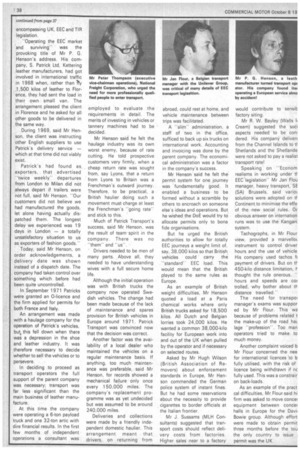The problems of hauling in Europe
Page 39

Page 40

If you've noticed an error in this article please click here to report it so we can fix it.
EEC conference report by John Darker
WE FRONTIER DELAYS' id imposts are unjustified, :cording to both a British rerator and a Belgian tranrort manager speaking at a rndon conference last eek.
The conference was entimi "Planning and operating ,ad transport within the EC legislation — practical sues for UK operators". It as marked by some frank reeking.
Opening the conference -mired by Brigadier Donald Kke, the director-general, iartered Institute of Transport • Mr Peter Thompson, execu/e vice-chairman (operations) ational Freight Corporation, ressed the need for more -ofessionally qualified men to -iter an industry growing on a orld-scale by eight per cent a ear. With world population 'creasing by two per cent a ear and with world wealth nproving by five per cent a ear — however unevenly Dread — there would be no ick of transport opportunities.
In the UK, said Mr hompson, over two million eople were employed in tran Dort and distribution. Traffic ) the EEC had grown by 55 per ant, but inwards traffic had Dared by 89 per cent. Perhaps, aid Mr Thompson, this xplained the disparity of rates ) and from Europe and also the ountry's balance of payments Iroblem.
Mr Thompson posed some ypical problems of transport aanagers in relation to the :ommon Market. How would :EC regulations affect the iperations? Where should lepots be located, in the UK or :ontinent, or both? What would ie the trend of wage rates, and nonetary values on both sides )f the channel? Which would be he low cost backloading area?
Operational research studies :ould help in the solution of hese problems, suggested Mr Thompson, but there had been
reported studies. "Perhaps he pragmatic road .haulage ndustry does not recognise the leed for your disciplines."
While accepting that likely egislation originating in Brussels could have a disastrous effect to the UK, Mr Thompson suggested that the typical 53hr working week of drivers in Britain was excessive and he felt that more sympathy should be shown to the aspirations of the trade unions here and in Europe to reduce hours.
A joint presentation on "Problems for the hire and reward operator" was given by Mr C. E. Williams, deputy operations director, MM Distribution Conzultants Ltd, and Mr P. G. Henson, director and transport manager, Patrick Transport Ltd.
Mr Williams felt the proposals for vehicle weights, dimensions, etc, might not be implemented before 1980, but fleet planners should be prepared for possible changes, Mr Williams suggested that it would be unwise to buy any vehicle whose height was greater than 'four metres and new vehicles should be purchased with ade quate power to satisfy the minimum of 7bhp per tonne. This in practice was a minimum of 175bhp for a 25-tonne-gross weight and 280bhp for a gross vehicle weight of 40 tonnes.
His confidence in EEC legislation had been shaken by the recent West German announcement of a reduction back from 8bhp to 6bhp per tonne, while the Italians, without consulting Brussels, proposed legislation for an increase to 8bhp per tonne.
As regards traction ratios, operators needed to examine their present fleet and if necessary buy new tractor and trailer units which can take full advantage if the maximum axle weights and maximum gross vehicle weights are permitted in the future.
Mr Williams stressed the need for an early decision on the proposed length increase of vehicles since an increase of one metre equalled an extra six cubic metres of carrying space, around 10 per cent. This also applied to a three-axle rigid, where there would be an increase in maximum permitted load of 0.6 tonnes.
The speaker felt it might be worth while to operate some three-axle rigids where volume rather than weight was the limiting factor, since operating costs would be significantly lower than a 12 metre artic and semi-trailer. There would be the possible advantage that a second driver would not be required with a journey over 450 kilometres.
Mr Williams noted that from January 1, 1978, all hire and reward operators, including the transport manager, would, as new entrants to the occupation, be required to show they were fit persons, financially sound and professionally competent. The EEC directive was aimed only at the hire and reward sector. Because there was no, legal distinction between hire and reward and own-account in the UK there could could be practical difficulties in implementing the new requirements.
It was, said Mr Williams, a matter for debate whether the necessity to pass examinations would improve the situation. He felt that though 0-licence applications had to sign that they will observe the law, the majority were not aware of what the law was in all its detail, encompassing UK, EEC and TIR legislation.
"Operating the EEC market and surviving" was the provoking title of Mr P. G.
Henson's address. His company, S. Patrick Ltd, Kettering leather manufacturers, had got involved in international traffic in 1968 when, rather than Thy 1,500 kilos of leather to Florence, they had sent the load in their own small van. The arrangement pleased the client in Florence and he asked for all other goods to be delivered in the same way.
During 1969, said Mr Henson, the client was instructing other English suppliers to use Patrick's delivery service — which at that time did not viably exist.
Patrick's had found as exporters, that advertised ''twice weeklydepartures from London to Milan did not always depart if trailers were not full, said Mr Henson. "Our customers did not believe we had manufactured the goods, let alone having actually dispatched them. The longest delay we experienced was 19 .days in London — a totally unsatisfactory situation to us as exporters of fashion goods.''
Today, said Mr Henson, on order acknowledgements, a delivery date was shown instead of a dispatch date. The company had taken control over something which before had been quite uncontrolled.
In September 1971 Patricks were granted an 0-licence and the firm applied for permits for both France and Italy.
An arrangement was made with a haulage company for the operation of Patrick's vehicles, but this fell down when there was a depression in the shoe and leather industry. It was therefore necessary to decide whether to sell the vehicles or to persevere.
In deciding to proceed as transport operators the full support of the parent company was necessary; transport was far less significant than the main business of leather manufacture.
At this time the company were operating a 6-ton payload truck and one 32-ton artic with dire financial results. In the first few months of independent operations a consultant was employed to evaluate the requirements in detail. The merits of investing in vehicles or tannery machines had to be decided.
Mr Hensonsaid he felt the haulage industry was its own worst enemy, because of rate cutting. He told prospective customers very firmly, when a cheap return rate was sought from, say Lyons, that a return from Lyons to Britain was a Frenchman's outward journey. Therefore, to be practical, a British haulier doing such a movement must charge at least
the Frenchman's "going rateand stick to this. •
Much of Patrick Transport's success, said Mr Henson, was
the result of team • spirit in the company. There.. was no "them" and "us".
Drivers needed to be men of many parts. . Above all, they needed to have understanding wives with a full secure home life.
Although the initial operation was with British trucks the company now operated Swe dish vehicles. The change had been made because of the lack of maintenance and spares provision for British vehicles in Europe around 1971. Patrick Transport was convinced now that the decision was correct.
Another factor was the availability of a local dealer who maintained the vehicles on a regular maintenance basis. If anything, too much mainten ance was preferable, said Mr Henson, for records showed a mechanical failure only once every 150,000 miles. The company's replacement programme was as yet undecided but was assumed to be around 240,000 miles.
Deliveries and collections were made by a friendly inde pendent domestic haulier. This arrangement meant that drivers, on returning from abroad, could rest at home, and vehicle maintenance between trips was facilitated.
A "slim" administration, a staff of two in the office, sufficed to back up six trucks on international work. Accounting and invoicing was done by the parent company. The economical administration was a factor in the company's success.
Mr Henson said he felt the permit system for one journey was fundamentally good. It enabled a business to be formed without a scramble by others to encroach on someone else's ideas and operations. But he wished the DoE would try to allocate permits only to bona fide organisations.
But he urged the British authorities to allow for totally EEC journeys a weight limit of, say, 38,000 kilos so that British. vehicles could carry the "standardEEC load. This would mean that the British played to the same rules as Europe.
As an example of British weight difficulties, Mr Henson quoted a load at a Paris chemical works where only British trucks asked for 18,500 kilos. All Dutch and Belgian lorries took 24,000 kilos. He wanted a common 38,000-kilo facility for European work into and out of the UK when pulled by the operator and if necessary on selected routes.
Asked by Mr Hugh Wilson (British Association of Removers) about enforcement standards in Europe, Mr Henson commended the German police system of instant fines. But he had some reservations about the necessity to provide cigarettes to border officials at the Italian frontier.
Mr J. Sussams (MLH Consultants) suggested that transport costs should reflect delivery costs from factories. Higher sales near to a factory would contribute to sensih factory siting.
Mr R. W. Bayley (Walls I! Cream) suggested the soci aspects needed to be con! dered. His company deliver( from the Channel Islands to tl Shetlands and the Shetlande were not asked to pay a realist transport rate!
Speaking on "Econom realisms in working under ti EECIegislation" Mr Jan Flou manager, heavy transport, SE (SA) Brussels, said variot solutions were adopted on tlContinent to minimise the effe of the new social. rules. Or obvious answer on internation runs was to use the Kangarc system.
Tachographs, in Mr Flour view, provided .a marvellot instrument to control driver hours and the use of vehicle His company used tachos payment of drivers. But on th 450-kilo distance limitation, h thought the rule onerous, " hours and speeds are cm trolled, why bother about th distance travelled
The need for transpol manager's exams was suppor ed by Mr Flour. This we because of problems related t the make-up of the road ha lage "profession". Too man operators tried to make to much money.
Another complaint voiced b Mr Flour concerned the nee for international licences 'to b fully utilised, with the risk of licence being withdrawn if nc fully used. This was a constrair on back-loads.
As an example of the pract cal difficulties, Mr Flour said hi firm was asked to move concei equipment between concer halls in Europe for the Davii Bowie group. Although effort were made to obtain permit three months before the tou the only country to issue permit was the UK




















































































